 to the Birds of Ambergris Caye.
to the Birds of Ambergris Caye. 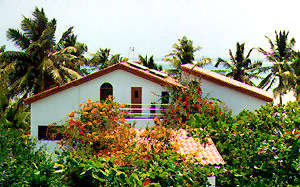 Quietly but steadily Ambergris Caye has been developing a private
bird sanctuary. The sanctuary is located in the narrow but rich
littoral forest region south of San Pedro, at Caribbean Villas.
Quietly but steadily Ambergris Caye has been developing a private
bird sanctuary. The sanctuary is located in the narrow but rich
littoral forest region south of San Pedro, at Caribbean Villas.
The littoral forest is filled with a vast abundance of fruiting
trees and shrubs. Some of the most important are the gumbo lumbo,
the bearded fig, the wild sapodilla and the coco plum. These trees
support a great array of birds.
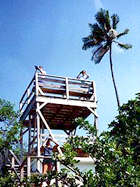 Sitting in the center of the littoral forest is their towering "people
perch". This multi-level observation tower was built especially for
birders. It provides birders a superb opportunity to view birds from
above the canopy of flowers and trees. This 360 degree view reaches
to the Caribbean to the east, Hol Chan Marine Preserve to the south,
San Pedro on the north and west to the San Pedro Lagoon and the
Chetumal Bay beyond.
Sitting in the center of the littoral forest is their towering "people
perch". This multi-level observation tower was built especially for
birders. It provides birders a superb opportunity to view birds from
above the canopy of flowers and trees. This 360 degree view reaches
to the Caribbean to the east, Hol Chan Marine Preserve to the south,
San Pedro on the north and west to the San Pedro Lagoon and the
Chetumal Bay beyond.
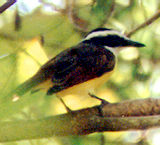 Birds frequently seen from the "people perch" include the white-eyed
vireo, Yucatan vireo, common tody flycatcher, great Kiskadee, black
catbird, yellow-bellied elaenia, white-collared seedeater,
golden-fronted
woodpecker, black-headed salator and the hooded oriole.
Birds frequently seen from the "people perch" include the white-eyed
vireo, Yucatan vireo, common tody flycatcher, great Kiskadee, black
catbird, yellow-bellied elaenia, white-collared seedeater,
golden-fronted
woodpecker, black-headed salator and the hooded oriole.
 Less frequent but recent visitors have been a pair of green-breasted
mango hummingbirds, numerous eastern kingbirds, both the scarlet
and summer tanagers, two regal white-crowned pigeons and a rose-
throated becard.
Less frequent but recent visitors have been a pair of green-breasted
mango hummingbirds, numerous eastern kingbirds, both the scarlet
and summer tanagers, two regal white-crowned pigeons and a rose-
throated becard.
One of my favorite birds, the yellow-backed oriole, returned about a
month ago. Its melodious song is very alluring and I frequently hear
it as it perches in the sprawling bougainvillaea near our balcony.
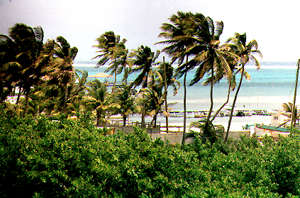 One of my favorite birds, the yellow-backed oriole, returned about a month ago. Its melodious song is very alluring and I frequently hear it as it perches in the sprawling bougainvillaea near our balcony.
One of my favorite birds, the yellow-backed oriole, returned about a month ago. Its melodious song is very alluring and I frequently hear it as it perches in the sprawling bougainvillaea near our balcony.
In Belizean Creole, blackbirds are birds such as grackles, orioles and more but blackbird generally refers to a family of songbirds. The family (Icteridae) includes orioles, cowbirds, meadowlarks, orependolas and grackles. Icteridae comes from Greek, which means jaundice or yellow, maybe referring to the orioles' color. Of the 94 species of blackbirds in the New World, 17 live in Belize. Blackbirds breed in almost every environment in the New World from Tierra del Fuego to Alaska. Belize is close to the heart of blackbird country. The adjacent lowland of the Mexico plateau is where orioles evolved and where the highest concentrations of blackbird species breed.
Blackbirds are unusual in having a particular behavior that enables them to exploit a wider variety of habitats and prey on species in a way that others cannot. This is referred as gaping. Most birds have strong muscles to close their bills to crush or grasp its prey. Blackbirds have strong muscles to open their Montezuma Orependola bills against the resistance of soil, roots, wood etc. e.g. They would insert their closed bill into an area such as soil or the bark of a tree and open the bill, exposing the hiding place of an insect or grub.
Only the female blackbird incubates the eggs and in almost all cases she builds the nest. However, with the Melodious Blackbird, the male feeds the female while she incubates the eggs, and in some situations he helps build the nest.
Orependolas nest in colonies. You may see groups of pendulous nests in a tree, with a male giving a bowing display at the nesting site as he sings away. Nest building can be very complex in many blackbirds such as orependolas and orioles. Other members of the family such as cowbirds are brood parasites who have lost the need and ability to care for their young or build a nest.
Yellow tailed Oriole Blackbirds build their nests in various areas and situations, always looking similar in structure and using similar materials. Orioles and orependoles first construct a loop or ring from which the nest hangs. Most of the weaving is done while upside down using the bill. Once a cup is formed the bird uses both the feet and the bill to manipulate the material. The birds may shred leaves with their bill while holding it down with the feet, producing fine materials to line the nest. Orioles and orependolas nests are often hung on branches away from predators and sometimes overhang water.
Red-Throated Ant-Tanager: One of the greatest attractions of tropical birds is the brilliance of their plumage. A birder from North America, where male birds are often much more colorful than the females, may be surprised to find that the sexes of most richly plumaged tropical species, including tanagers, parrots, and orioles, are alike or similar. Many of the more brilliantly colored birds tend to frequent the upper levels of the forest and open country, whereas those that inhabit the dimly lit undergrowth mostly wear dark, dull colors, often with attractively barred or streaked patterns. Birds such as the Barred Antshrike and Dotted-wing Antwren have contrasting areas of white buff and or black that are normally concealed but can be strikingly exposed in display.
Many of Belize's birds, especially some of the thrushes, are fine songsters. The dawn songs of the Melodious Blackbirds are quite lovely. The Rufous-tailed Jacamars have charming, elaborate songs. Trogons sing melodiously, and the song of the tinamous can be deeply stirring. At times, in the deep forests and thickets, we may have to identify birds by their songs and calls. Although sometimes we may not get a chance to see them, knowing their vocalizations makes it easy to identify them. It is fascinating seeing these Belize birds. For great birding trips contact as us at Birding in Belize.
Very soon birders can look for signs identifying this area as
a private sanctuary open to birders from 6 a.m. to 6 p.m.
Contact Caribbean Villas Hotel for additional information at
226-2715 or [email protected].
Here are other related birding links about the island:
For a listing of tour guides in the area, click here.
For a historical prespective Bruce Miller wrote an article Ornithology in Belize 1960-98.
http://scientific-papers.s3.amazonaws.com/Miller_etal1998.pdf
Here is a list of the birds spotted recently on a birding expedition:

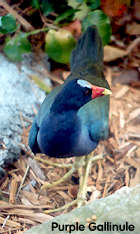
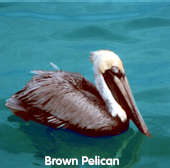
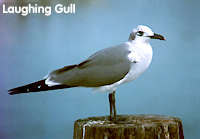
|
Pied-billed Grebe
Anhinga
Brown Pelican
Magnificent Frigatebird
Double-crested Cormorant
Olivaceous Cormorant
Royal Tern
Gull-billed tern
Forster Turn
Least Tern
Sandwich Tern
Laughing Gull
Ring-billed Gull
Herring Gull
American Golden Plover
Wilson's Plover
Semipalmated Plover
Snowy Plover
Black-bellied Plover
Collared Plover
Ruddy Turnstone
Killdeer
Spotted Sandpiper
Bairds
Solitary Sandpiper
Upland Sandpipper
Least Sandpiper
Western Sandpiper
Pectoral Sandpiper
Stilt Sandpiper
Short-billed Dowitcher
Common Snipe
Sora
Little Blue Heron
Great Blue Heron
Great Blue Heron (white phase)
Snowy Egret
Great Egret
Black-crowned Night-Heron
Yellow-crowned Night-Heron
Northern Boat-billed Heron
Cattle Egret
Green Heron
Reddish Egret
American Bittern
Least Bittern
Bare-throated Tiger Heron
Tri-colored Heron
White Ibis
Wood Stork
Black-necked stilt
Willet
Whimbrel
Sanderling
Lesser Yellowlegs
Greater Yellowlegs
Roseate Spoonbill
Clapper Rail
Gray-necked Rail
Purple Gallinule
Sungrebe
Sandhill Crane
American Coot
Swainson's Thrush
Louisana Water Thrush
Northern Water Thrush
Wood Thrush
Ringed Kingfisher
Belted Kingfisher
Green Kingfisher
Osprey
Common Black Hawk
Great Black Hawk
Roadside Hawk
Gray Hawk
White-tailed Hawk
Black-shouldered Hawk
American Kestrel
Merlin
Turkey Vulture
Black Vulture
Laughing Falcon
Peregrine Falcon
White-tailed Kite
Black-and-White Hawk-Eagle
Chachalaca
Common Night Hawk
Lesser Night Hawk
Common Pauraque
Potoo
Blue-Winged Teal
Green-winged Teal
Northern Shovler
Blk-Bellied Whistling Duck
White-crowned Pigeon
Pale-vented Pigeon
Caribbean Dove
White-winged Dove
Common Ground Dove
Ruddy Ground Dove
Gray-headed Dove
Gray-fronted Dove
Rock Dove
Aztec Parakeet
Mangrove Swallow
Cliff Swallow
Cave Swallow
Bank Swallow
Barn Swallow
Rough-winged Swallow
Tree Swallow
Gray-breasted Martin
Brown Jay
Yucatan Jay
Tropical Mockingbird
Gray Catbird
Black Catbird
Black Albinated Catbird
Clay-colored Robin
Summer Tanager
Scarlet Tanager
Crimson-collared Tanager
Blue-gray Tanager
|
Black-headed Saltator
Buff-throated Saltator
Gray Saltator
Blue Grosbeak
Rose-breasted Grosbeak
Indigo Bunting
Dickcissel
American Red Start
Bay-breasted
Black-throated Blue Warbler
Black-throated Green
Black and White Warbler
Blue-winged Warbler
Blackburnian Warbler
Common Yellowthroat
Canadian Warbler
Chestnut-sided Warbler
Worm-eating Warbler
Mangrove Warbler
Magnolia
Mourning Warbler
Northern Parula
Palm
Pine
Prairie
Yellow Warbler
Yellowthroated Warbler
Prothonotary Warbler
Tennessee Warbler
Townsend's Warbler
Swainson's Warbler
Yellow-breasted Chat
Bananaquit
Ovenbird
Green-backed Sparrow
Lark Sparrow
Clay-colored Sparrow
Cedar Waxwing
Solitary Vireo
Mangrove Vireo
Yellow-throated Vireo
White-eyed Vireo
Red-eyed Vireo
Yucatan Vireo
Cozumel Vireo
Philadelphia Vireo
Rufous-browed Peppershrike
Veery
Bronzed Cowbird
Great-tailed Grackle
Baltimore Oriole
Hooded Oriole
Orange Oriole
Altamira Oriole
Orchard Oriole
Yellow-backed Oriole
Yellow-billed Cacique
Yellow-headed Blackbird
Oropendola
White-collared Seedeater
Cinnamon-rumped Seedeater
Black Seedeater
Sharpe's Seedeater
Clay-colored Sparrow
Chipping Sparrow
Bobolink
Cinnamon Hummingbird
Rufous-tailed Hummingbird
Little Hermit
Ruby-throated Hummingbird
Green-breasted Mango
Forked-tailed Emerald
Masked Tityra
Great Kiskadee
Social Flycatcher
Sulphur-bellied Flycatcher
Streaked Flycatcher
Forked-tailed Flycatcher
Great-crested Flycatcher
Boat-billed Flycatcher
Scissor-tailed Flycatcher
Olive-sided Flycatcher
Common-tody Flycatcher
Least Flycatcher
Alder Flycatcher
Duskey-capped Flycatcher
Rose-throated Becard
Tropical Pewee
Eastern Wood Pewee
Tropical Kingbird
Eastern Kingbird
Squirrel Cuckoo
Mangrove Cuckoo
Black-billed Cuckoo
Groove-billed Ani
Smooth-billed Ani
Yellow-bellied Elaenia
Caribbean Elaenia
Citreoline Trogon
Black Headed Trogon
Golden-fronted Woodpecker
Lineated Woodpecker
Yucatan Woodpecker/Red-vented
Ladder-backed Woodpecker
Yellow-bellied Sapsucker
|
|
Birding Videos.....
- Yellow-throated Euphonia, 1min. Filmed at Crested Caracara Private Reserve, Belize.
- Crested Caracara, 1min. Filmed at Crested Caracara Private Reserve, Belize
- Black and White Owl, 1/2min. Filmed at Chan Chich Lodge, Belize.
- Rose throated Becard, 1min.
- Cinnamon Becard, 1/2min. Filmed at Chan Chich Lodge, Belize
- Black throated Shrike Tanager, 1min.
- Black-and-white Owl - Cockscomb Basin Wildlife Sanctuary, 1/2min. For me, filming at night, by myself, is always a challenge. And here, my best spotlight had already failed (!) so there is a fair amount of noise. But, in my mind at least, this is a beauty I cannot just discard....
- Yellow-billed Cuckoo, 1/2min. Filmed at Crested Caracara Private Reserve, Belize.
- Self-portrait, with Roni Martinez - Despair Camp, 1/3min.
- Smoky-brown Woodpecker - BFREE , 1.5min. Shortly after sunrise on the Northern Boundary trail this guy was hammering away. This clip starts off at full speed then transitions to 1/2 speed, then 1/4 speed to be able to see more of what he is doing.
- Painted Bunting - Maya Centre, Belize, 1min. Located at the entrance to the Cockscomb Basin Wildlife Sanctuary, Maya Centre is just the second place I have seen the Painted Bunting. My only other sighting was at Caracol and I did not have enough time to film it. The only reason I was able to see and film this one in Maya Centre is due to the observations of my friend, CBWS Ranger Brijilio Bolon who lives in Maya Centre.
- Green-breasted Mango, 1.5min. April 14, 2016, morning at Crested Caracara Private Reserve, Cayo, Belize. A bunch of Belizean friends have come to join me birding on my last morning in the field. They are all great birders and we saw a lot of birds, many of which I was unable to film due to a camera malfunction (aka Operator Error). But there was a hummingbird that looked a little different. After some excitement and a lot of discussion, it was determined to be a Green-breasted Mango, a real beauty but we were hoping for something more uncommon. But still, this guy looks a little different – what is up with the obvious post-ocular eye spot? Is that common?
- Orange-breasted Falcon - Hidden Valley Inn, 1/2min. The folks at hidden Valley Inn were kind enough to let me move around their property seeking birds....
- Boat billed Heron, 1min.
- Tropical Pewee, 1/2min.
- Black and white Owl, 1min.
- Red throated Ant Tanager, 1min.
- White Ibis, 1min.
- Plain Chachalaca, 1/2min.
- White Ibis, 1min.
- Plain Chachalaca, 1min.
- Little Blue Heron, 1/2min.
- Great Kiskadee, 1/2min.
- Black-headed Trogon, 1min.
- Acorn Woodpecker, 1min.
- Least Sandpiper, 1min.
- Glossy Ibis, 1/4min.
- Ruddy Ground Dove, 1/2min.
- Vermilion Flycatcher, 1/2min.
- Northern Jacana, 10sec.
- Glossy Ibis close, 1min.
- Great Egret lagoon, 1min.
- Mangrove Swallow, 1/2min.
- Ruddy Ground Dove, 1min.
- Green Heron, 1.5min.
- Ringed Kingfisher, 1/2min.
- White winged Dove, 1/2min.
- Prothonotary Warbler, 5sec.
- Spotted Sandpiper, 1min.
- Great Blue Heron, 1/2min.
- Yucatan Flycatcher, 1/2min.
- Ringed Kingfisher, 1/2min.








 Quietly but steadily Ambergris Caye has been developing a private
bird sanctuary. The sanctuary is located in the narrow but rich
littoral forest region south of San Pedro, at Caribbean Villas.
Quietly but steadily Ambergris Caye has been developing a private
bird sanctuary. The sanctuary is located in the narrow but rich
littoral forest region south of San Pedro, at Caribbean Villas.
 Sitting in the center of the littoral forest is their towering "people
perch". This multi-level observation tower was built especially for
birders. It provides birders a superb opportunity to view birds from
above the canopy of flowers and trees. This 360 degree view reaches
to the Caribbean to the east, Hol Chan Marine Preserve to the south,
San Pedro on the north and west to the San Pedro Lagoon and the
Chetumal Bay beyond.
Sitting in the center of the littoral forest is their towering "people
perch". This multi-level observation tower was built especially for
birders. It provides birders a superb opportunity to view birds from
above the canopy of flowers and trees. This 360 degree view reaches
to the Caribbean to the east, Hol Chan Marine Preserve to the south,
San Pedro on the north and west to the San Pedro Lagoon and the
Chetumal Bay beyond.
 Birds frequently seen from the "people perch" include the white-eyed
vireo, Yucatan vireo, common tody flycatcher, great Kiskadee, black
catbird, yellow-bellied elaenia, white-collared seedeater,
golden-fronted
woodpecker, black-headed salator and the hooded oriole.
Birds frequently seen from the "people perch" include the white-eyed
vireo, Yucatan vireo, common tody flycatcher, great Kiskadee, black
catbird, yellow-bellied elaenia, white-collared seedeater,
golden-fronted
woodpecker, black-headed salator and the hooded oriole.
 Less frequent but recent visitors have been a pair of green-breasted
mango hummingbirds, numerous eastern kingbirds, both the scarlet
and summer tanagers, two regal white-crowned pigeons and a rose-
throated becard.
Less frequent but recent visitors have been a pair of green-breasted
mango hummingbirds, numerous eastern kingbirds, both the scarlet
and summer tanagers, two regal white-crowned pigeons and a rose-
throated becard.
 One of my favorite birds, the yellow-backed oriole, returned about a month ago. Its melodious song is very alluring and I frequently hear it as it perches in the sprawling bougainvillaea near our balcony.
One of my favorite birds, the yellow-backed oriole, returned about a month ago. Its melodious song is very alluring and I frequently hear it as it perches in the sprawling bougainvillaea near our balcony.












